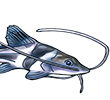I thought I would procrastinate a bit this morning and write a brief narrative on one of my routine biomonitoring sites on the Bivane River, a tributary of the Phongolo River. The reason I selected to write about this particular site is that it possesses a unique ichthyofauna community compared to the remainder of the biomonitoring sites I usually sample.
Site Location and Description
The site is located between the towns of Vryheid and Paulpietersburg in KwaZulu-Natal. See map below.
The site lies within the Lowveld Ecoregion, proximal with the boundary of the North-Eastern Uplands Ecoregion. The topography of this specific area within the ecoregion is typically open hills and low mounatins with high relief. Mean annual precipitation tends to be moderate with approximately 1000 mm/pa.
This reach of the Bivane River is uniform in terms of channel features, is relatively constrained and possesses low sinuosity. The channel is typically a rapid-pool complex with a boulder and cobble dominated substrate. Pockets of sand are present along the margins with slower water velocities. The marginal zone is dominated by Phragmites australis. The photographs below illustrate the site during September and December 2016, respectively.


There is temporal variation pertaining to selected water quality variables. Although, temperature does not vary considerably, there is evidence that water clarity, Soluble Reactive Phosphate (SRP) and Chlorophyll-a variessubstantially. See figures below. Impacts to the site include water quality alteration from upstream land-use, albeit the impact is low to moderate and further supported to some degree by the absence of excessive filamentous algal growth and the presence of water-quality sensitive insect families such as Perlidae (Plecoptera) and Heptageniidae (Ephemeroptera). A critical impact is the intensive and extensive growth of alien invasive plants within the non-marginal zone. The dam downstream is likely to negatively influence connectivity required for migratory species.
Ichthyofauna Species
The rheophilic guild within the site consisted of the following:







It was interesting to note the colour variation within the same population. Note the missing right pelvic was due to collection of tissue for possible future genetic studies.
Labeobarbus marequensis

Species collected within the pool hydraulic biotope included:
Marcusenius pongolensis

Opsaridium peringueyi ( I do not have decent photos of this species)
Unfortunately, a single large mouth bass was observed at the site; the species is invasive in South Africa and is known to have a significant effect on indigenous species assemblages. The Chiloglanis are possibly safe due to the dorsal and pectoral spines, and having been stung and envenomated many times myself by this genus, any predator will certainly think twice.
For those that do not know the initial pierce that breaks the skin feels like a large hypodermic needle and subsequently, joint pain travels from the site upwards until you have a migraine and then you feel like vomitting, but you still have to carry on sampling
I intend to sample the site in November and will hopefully provide some feedback as to what I record. I am still missing species that potentially occur at the site and hope to find them.






